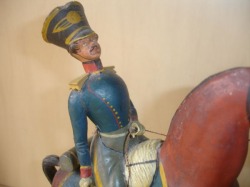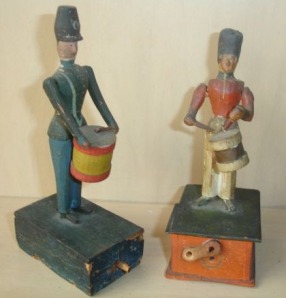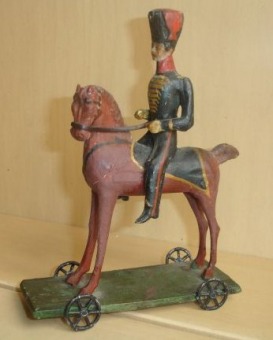|
Of all my collections, toys from the Erzgebirge region of Germany remain my favorites. I've been seriously collecting these for about ten years now, but only recently found out why. Although I obviously knew my forefathers on both sides emigrated from Germany, I only found out a month ago, quite by accident when doing a Google search, that my maternal great grandparents were born in the heart of the Erzgebirge region in the 1840s. How strange is that? I suppose that explains my fascination with toys from this region. It all comes down to genetics!  Except for some breaks or cracks in the papier-mache here and there, the piece is complete. Although condition is very good, on items of this age and rarity condition can be overlooked. Where are you going to find another? This soldier and horse on rocker dates to the 1820s or 1830s. It comes from an estate sale of a family in the Zoar community in northeastern Ohio. The Zoars were a German religious community much like the Amanas where I was born and raised. What I find most interesting is that items like the one above were imported to the US from Germany by New York City toy stores in the tens of thousands in the early 1800s. A friend, Mary Audrey Apple, has done research on the early import of Erzgebirge toys to the US. By going through original ledgers of toy dealers in New York City found in the Winterthur library, she discovered the toys were shipped over in amazing numbers and the competition between the handful of toy stores in New York City was amazing. However, finding an example of a toy such as this today is like finding a needle in a haystack. These were delicate and well played with toys, so most ended up broken and were thrown away. Above are two early (1830s) examples of Erzgebirge soldier Klimperkaestchen, which have cranks which when turned move the arms of the soldiers. The base on the left is covered in old paper, while the base on the right has its original orange paint.  The soldier on the right has facial features and arms created of Brotteig (bread dough). This was typical of toys of that era. The bread dough would harden and then be painted. Note the round nose on the soldier on the right and the "puffy" arms. The soldier on the left has a carved nose -- also desirable because it shows a high level of craftsmanship -- but dates this piece a little later than the bread dough figures. REAR VIEW OF KLIMPERKAESTCHEN The soldier on horse pull toy above is a bit confusing to me and my friends in Germany, Maria and Dieter, who have such a wonderful collection and are extremely knowledgeable about the history of these toys. Although obviously a very early piece with features made of Brotteig, pull toys of this age would have had wooden wheels as my other pull toy above. The metal wheels are early ones, but they may be replacements of wooden wheels which would no doubt tend to come off if played with a lot. Still, the papier-mache is in amazing original condition for its age!
0 Comments
Leave a Reply. |
Archives
May 2015
Susan's PageWelcome to Living Tastefully’s “Antique of the Week” page. Our love of antiques is reflected in every aspect of our everyday lives. We are passionate about collecting and also love functional antiques that can actually be used and not only admired. Hopefully we can inspire you to incorporate antiques in your home and your life to add charm and beauty to your surroundings.
All
Links
|






 RSS Feed
RSS Feed